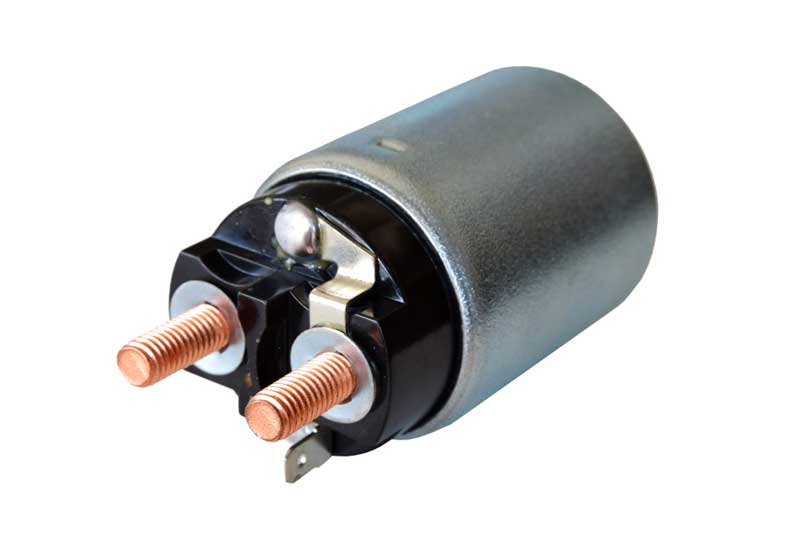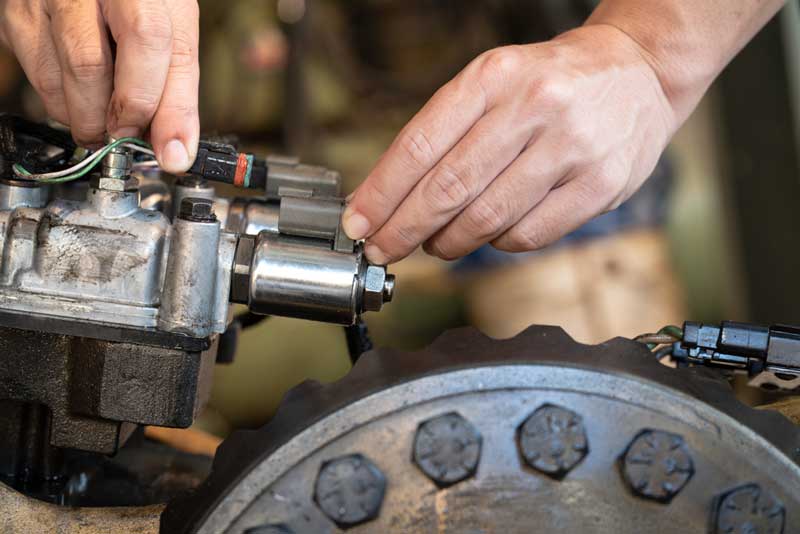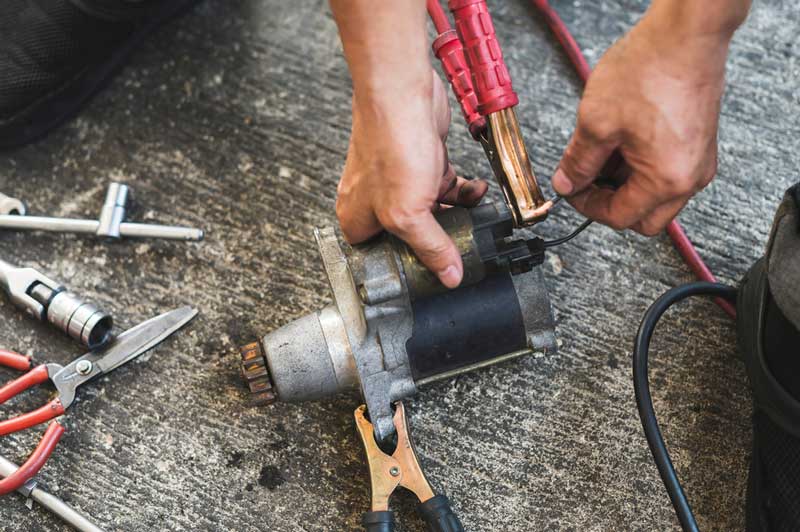Is your car having starting issues that you quickly want to resolve? Are you wondering if the problem is with the solenoid, and you will like to know how to test a solenoid?
A starter solenoid is one of the few components for starting your car. A faulty starter solenoid can be caused by a dead battery, loose battery cable, or corroded battery terminal.
In this article, we will explain what a solenoid is, provide you with four simple steps on how to test a solenoid, and as well identify the signs of a faulty starter solenoid.
Let’s begin!
How to Test a Starter Solenoid
- Locate your starter solenoid
- Conduct a click test and check the battery
- Test the current from the solenoid
- Measure the voltage drop from the solenoid
The following are some of the tools necessary to carry out this test:
- A spanners and wrenches set (just in case the components need to be moved)
- A digital multimeter or voltmeter
- A small jumper wire
It is also ideal that someone is present to help you press your start button, or turn your key switch when performing tests.
Let us now see how tests on the starter solenoid could be carried out.
Locate the Starter Solenoid
You can locate the starter solenoid easily by following the simple steps below:
1. Open Your Vehicle’s Bonnet
Your starter solenoid can be found in the engine compartment of the vehicle. It can be accessed by pulling the hood release handle close to the driver’s door. After this, release the safety latch on your vehicle’s front part, to open the hood.
2. Find The Starter
The starter is directly connected to the positive battery cable of your car. To locate the starter, simply locate the battery’s positive terminal, and trace the vehicle’s positive battery wire.
3. Identify The Starter Solenoid
The starter solenoid can be easily identified when you have located the car starter. It is a smaller cylinder fastened to the side or top of the car starter.
There are three connection points on the starter motor solenoid, two of the points are the output and input terminals of the solenoid, while the third is for the control circuit terminal.
Your starter motor solenoid is connected to your car battery, by a wire carried by the input starter terminal. The vehicle’s starter motor is powered by a thick cable, carried by the output starter terminal.
Now that you have located your starter solenoid, a click test can be conducted.
Perform a Click Test and Check the Battery
Carry out a click test after locating your starter solenoid, to check whether the solenoid is properly functioning.
Observe a clicking sound while someone turns on the ignition switch. Stand close to the engine, and have someone turn the ignition switch on. A clicking sound should be heard, as soon as the starter solenoid engages.
If a clicking noise can be heard, but your starter motor is not moving, the starter solenoid may be engaged, or the battery power it receives is not enough.
If there is no sound, your starter solenoid probably has a fault, or you may have a flat car battery. The battery could be tested in this situation, to see if it is the reason behind your starter issue.
Also Read: How Long Does an Alternator Last (Every Factor Explained)
Test the Car Battery
After turning on your key switch, if the starter doesn’t engage, you can use a voltmeter to test the battery voltage. Here’s how this can be done:
- Connect the voltmeter’s red (positive) lead wire to the positive terminal of your battery.
- Next, the voltmeter’s black (negative) lead wire, should be connected to the battery’s negative terminal.
- Check the reading on the voltmeter — Before starting the vehicle, the battery’s voltage should be about 12 volts. If there is no reading on the voltmeter, your battery may be dead or too low.
If there are no issues with the battery voltage, but the starter solenoid makes a faint clicking sound, you should check your control circuit for current resistance.

Test the Current From the Solenoid
If the solenoid makes a faint clicking sound, there could be a fault in the starter solenoid or control circuit.
Check your control circuit for current resistance, to identify the root of the starter issues.
Look Out For Current Resistance Using A Jumper Wire
A thin cable, known as an ignition switch connection, which is attached to the starter solenoid, helps complete the control circuit. The connection has current only when your ignition key is turned on, or your start button is pressed.
A jumper wire completes the circuit and can be easily used to test the control circuit for current resistance. Here’s how to go about it:
- Connect the jumper wire from your ignition circuit lead (control circuit terminal) to your input solenoid terminal.
- Listen for a solid “click” sound from your starter solenoid. If all connections are in order, but no clicking sound is heard, your starter motor solenoid could have a fault.
A test light can also determine if the starter motor solenoid causes your starter problem. Here’s how to go about it:
Check Current Resistance Using a Test Light
A test light can be used to test for current resistance, by following these steps:
- The input solenoid terminal, should be connected to the test light’s red (positive) lead wire.
- Then, the black (negative) lead wire should be grounded from the test light to a surface of bare metal on your car. The battery’s negative terminal can also be used as the ground connection point.
- Next, check the test light— If the light turns on, it means that the battery is transmitting power to the starter solenoid.
- Now, check whether the starter motor solenoid is effectively transferring power. This can be done by shifting the positive lead wire on the test light, to your output solenoid terminal. The black (negative) lead should, however, be kept grounded.
Someone should press your starter button or turn on your ignition key.
Check the test light — if the light does not turn on, it is possible that the solenoid isn’t properly transferring power, and may need to be replaced. If this light comes on, but the starter doesn’t engage, or there isn’t any clicking sound, your car starter has an issue. You will need to replace your starter for this issue to be resolved.
If you notice a faint clicking sound, but the test light is turned on, your starter solenoid’s voltage drop may need to be measured. Here is how:
Measure the Drop in Voltage From the Solenoid
The battery may be transferring insufficient power to the solenoid if a faint clicking noise is produced when your key switch is turned on. In this situation, measure the starter motor solenoid’s voltage drop.
This can be checked by setting the multimeter to either 20 volts or 15 volts, on a DC Voltage scale. Following this, you could take these steps:
- First of all, measure the battery’s voltage drop. This determines how much voltage, is required to engage the starter motor solenoid. This can be done by connecting the multimeter’s positive (red) lead wire, to the battery’s positive terminal.
- Next, the multimeter’s negative (black) lead wire, should be connected to the battery’s negative terminal.
- Check the reading on the multimeter — when the car battery is not powering anything, it should have an approximate output of 12 Volts.
- While you hold the multimeter, someone should press your starter button or switch on your ignition switch. If the battery is working fine, the reading on the multimeter should drop by about half of one volt (0.5 Volts), from the initial 12 Volts.
- Next, the solenoid’s voltage drop should be measured. This is done by connecting the multimeter’s red (positive) lead cable, to your output solenoid terminal. The multimeter’s black (negative) lead cable, should be connected to the input solenoid terminal.
- Lastly, as you monitor the drop in the voltage reading, the ignition switch should be turned on. The battery’s voltage drop reading (approximately 0.5 Volts), should match this reading. If the two readings are the same, your car starter is likely the cause of the starter problem, not the starter solenoid.
- If there is a voltage drop of fewer than 0.5 Volts, your solenoid is faulty. If the observed voltage drop is too much, a bad electrical connection could be the cause.
Here is a video on how to test a solenoid:
Review of a Solenoid
In summary, a starter solenoid is among the components of your car that start the vehicle. Generally, it is located between the car’s engine and ignition module.
Solenoids (also known as starter relays or starter solenoids) function, by receiving small electrical currents transferred from your ignition system, and larger currents from your vehicle’s battery.
The solenoid closes two metal points or contacts when you turn the key. This way, the starter solenoid relays currents from your ignition, to your starter motor. This sets off a series of electrical reactions, that ultimately start your combustion engine.
Consider the starter, the first spark that ignites your car’s engine and makes all its intricate mechanical parts turn simultaneously.
Where Are Solenoids Located?
A solenoid’s location varies, depending on the model and makes of your vehicle. Most vehicles have their starter solenoids mounted directly on their starter motors, and connected to certain other “starter” parts, like your starter control terminal and starter gear.
So, you may ask, what is the exact definition of the starter motor? It is essentially an electric and magnetic motor, connected to your car’s battery, made to take in low current and start turning the appropriately called starter gear, and turning again to start a relatively large electric reaction, and subsequently, the entire engine.
Meanwhile, some vehicles have their starter solenoids mounted somewhere else in their engine compartment. Notwithstanding, the starter solenoid can always be found between the engine and ignition, so consult the owner’s manual for more information on the precise location of the solenoid, in the model and make of your car.

Why Is My Starter Solenoid Faulty?
Some likely causes of a faulty starter solenoid are Dead Battery, Loose Battery Cable, Or Corroded Battery Terminal
You will require electric power, whether you are working with the solenoid of a small-sized lawn mower, or that of a tractor. So, if your battery cable is loose, your battery terminal is corroded, or your battery is dead, your starter solenoid will likely be defective.
Faulty Wiring
A high electric current may flow through your solenoid if the starter or control circuit has faulty connections. This could lead to excessive heat, which would weld critical components together and result in a faulty starter motor solenoid.
Worn-Out Wiring
If your wiring is worn-out, your starter motor solenoid could have an insufficient current supply. This could lead to a faulty starter motor or a bad solenoid.
Oil Leaks
If there are oil leaks in your car, some of the leaking oil could come in contact with your starter solenoid, causing its vital components to corrode, resulting in a faulty solenoid.
What Are the Indicators of a Faulty Starter Solenoid?
There are several signs to watch out for if you think your starter solenoid is faulty. The majority of these are similar to indicators of a defective starter relay
The following are the major warning signs to watch out for:
Engine Does Not Start
Your starter motor will not work when your starter solenoid is faulty. This means your engine will not start when the start button is pressed or your starter switch is turned on.
However, the car’s neutral safety switch could prevent the engine from cranking, if your car’s transmission is automatic.
Your neutral safety switch has the primary function, of ensuring that your vehicle can start only when your transmission isn’t in gear. So, if the engine doesn’t start, ensure that the transmission is in a park or neutral.
No Click Noise When Starting The Engine
When the starter switch is turned on, the clicking sound you notice either comes from your starter relay or starter solenoid. So, if this sound isn’t heard when you start your vehicle, your starter relay could be faulty, or you could have a malfunctioning starter solenoid.
Also Read: Wheel Alignment Cost
Frequently Asked Questions – How to Test a Solenoid
How do you check if a solenoid is working?
Try to listen closely for a “clicking” sound. Strong and audible clicks indicate that the starter solenoid has sufficient power, and is operating properly. If you hear a repetitive or quiet clicking, your solenoid may not be strong enough. It could also mean the battery isn’t supplying enough power to the solenoid.
Should a solenoid have continuity?
Although you would have a defective solenoid coil, if it had NO continuity or was electrically open, having continuity does not necessarily mean that the component isn’t bad. For example, the armature of the solenoid may be seized in place and unable to move, or whatever the armature is connected to may also have a fault.
How do you know if a solenoid is bad on a multimeter?
You could sometimes see a normal reading on your digital multimeter, even though the coil isn’t functioning. In this case, a screwdriver can be placed close to the armature and energize the starter solenoids. If a magnet is present, your coil is sound. If not, it is faulty and needs to be replaced.
Will a bad solenoid click?
The issue may be with the starter solenoid. If you hear a single clicking sound, from underneath the car or from your engine compartment, this could imply that the starter solenoid may be attempting to engage. Still, the vehicle’s internal components cannot move and are unable to function properly. Repeated “click” sounds typically indicate that the battery is dead.
How many ohms should a solenoid have?
When used for irrigation, a good solenoid has a resistance ranging from 20 to 60 ohms. Resistance measurements are best compared with the resistance of a brand new solenoid. For instance, a solenoid with a resistance measurement of 44 ohms would be regarded as good, because the resistance falls within the 20 to 60 ohms range.
Conclusion – How to Test a Solenoid
You have finished the steps to know how you can test your starter solenoid. Still, experiencing problems? Ensure that the solenoid is free of all grease or corrosion.
The vehicle could experience a power loss if these are present on its surface. With these guidelines, you should now be able to identify if your solenoid is receiving enough voltage, to adequately power your car. So travel safely and have fun!

